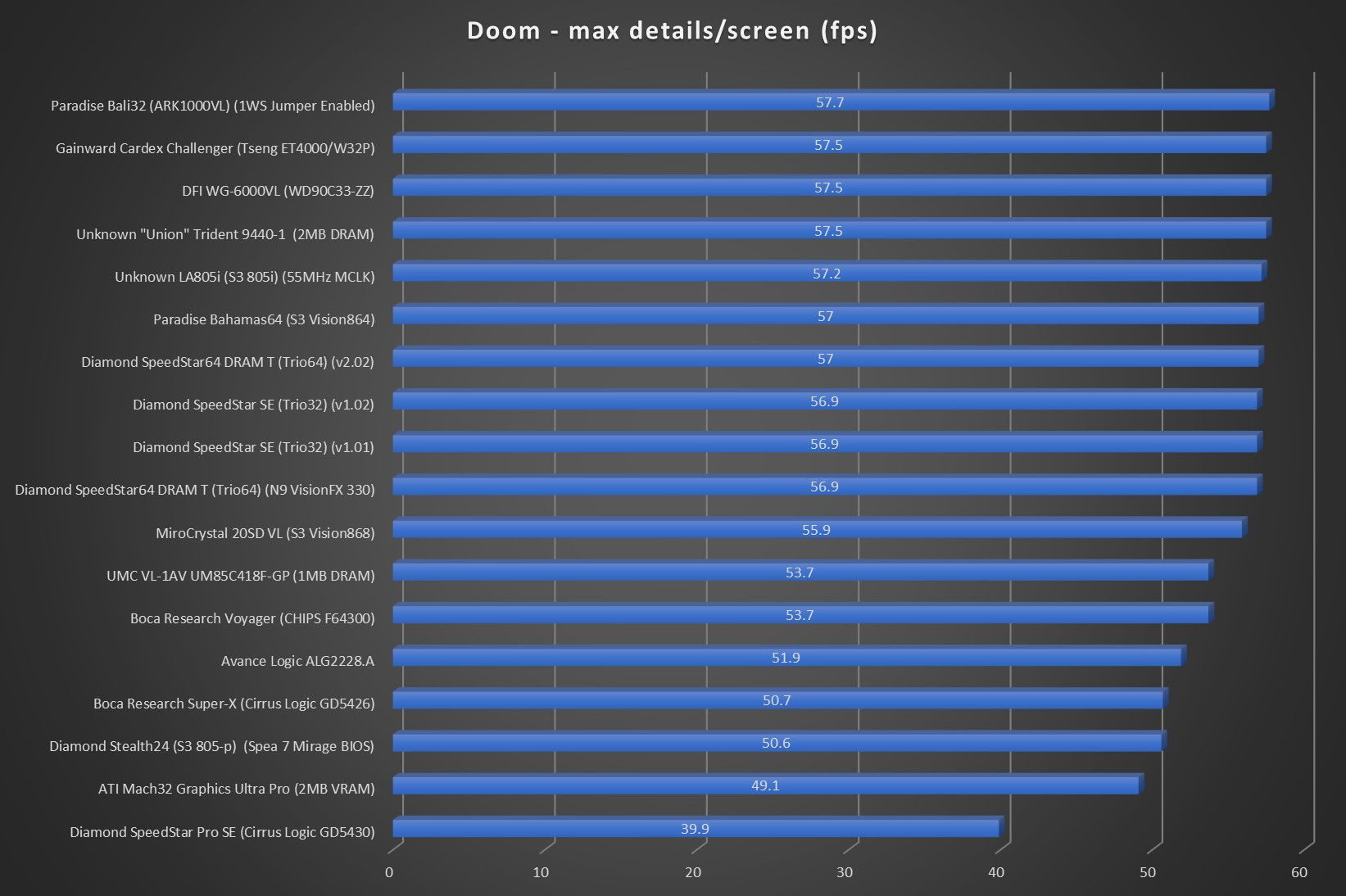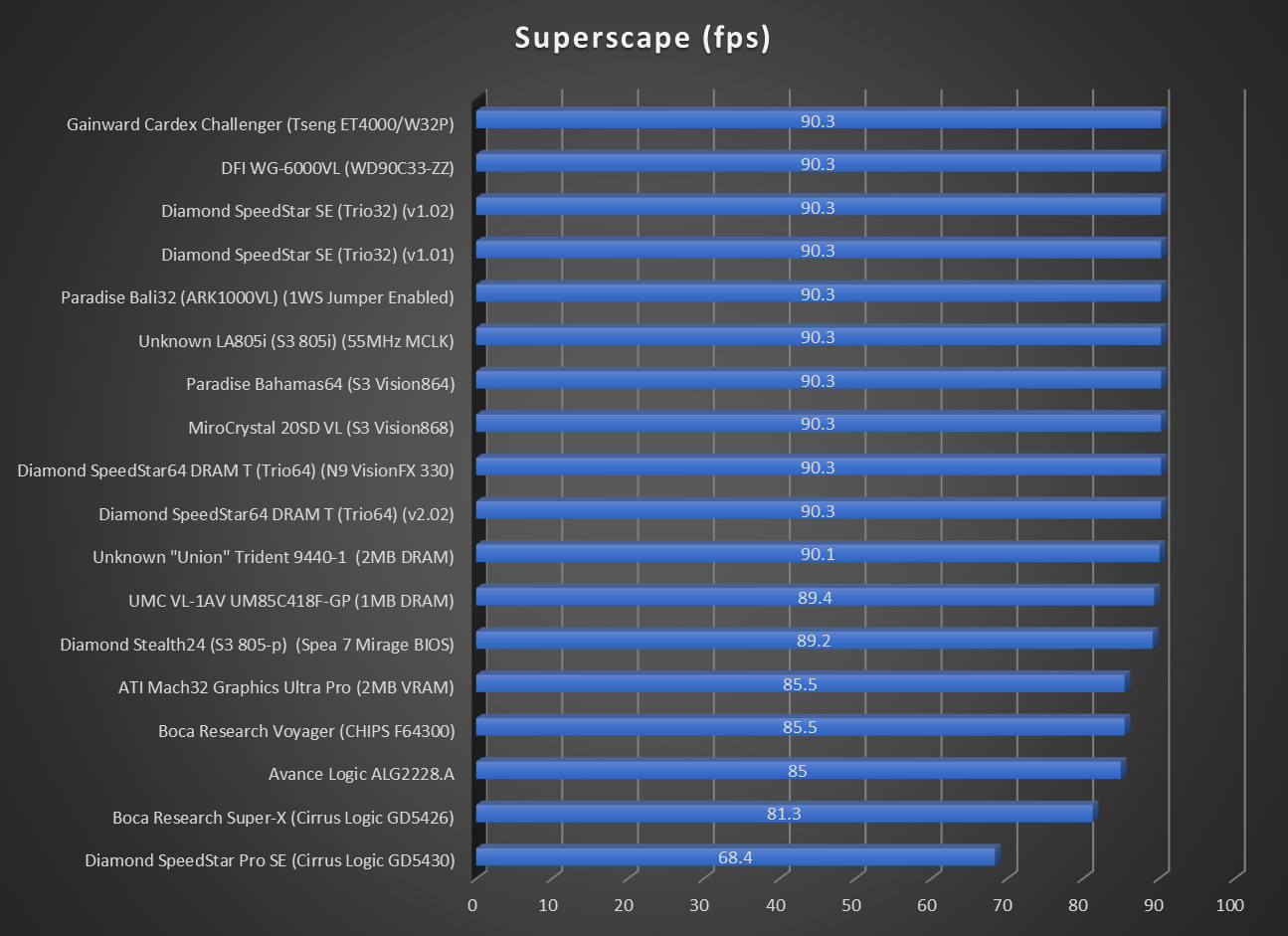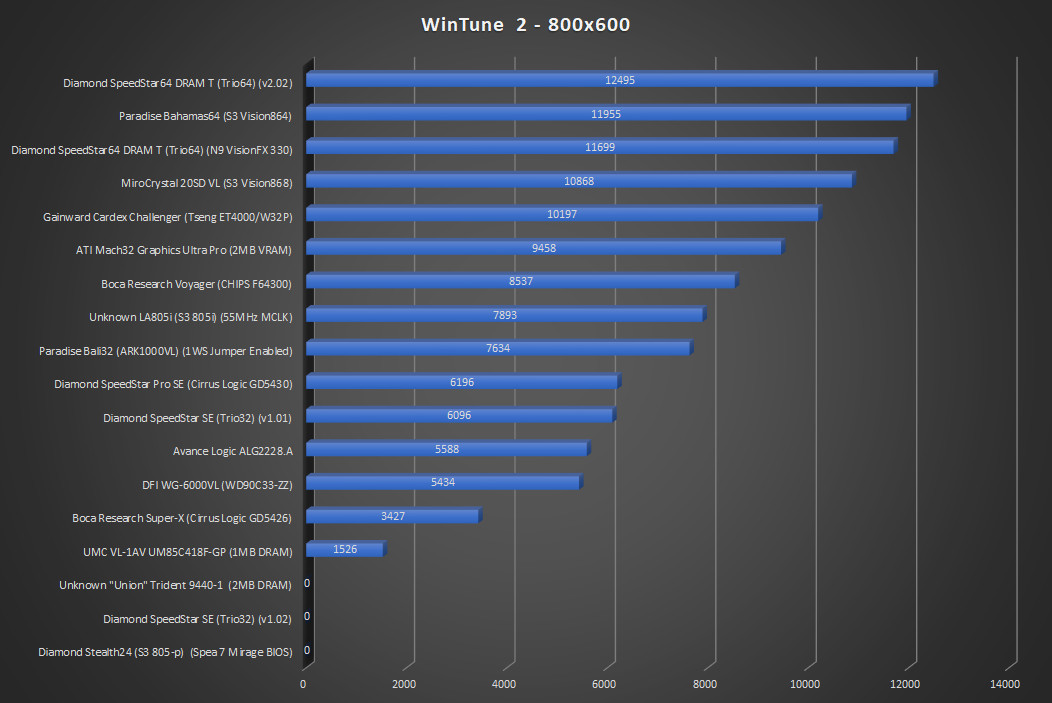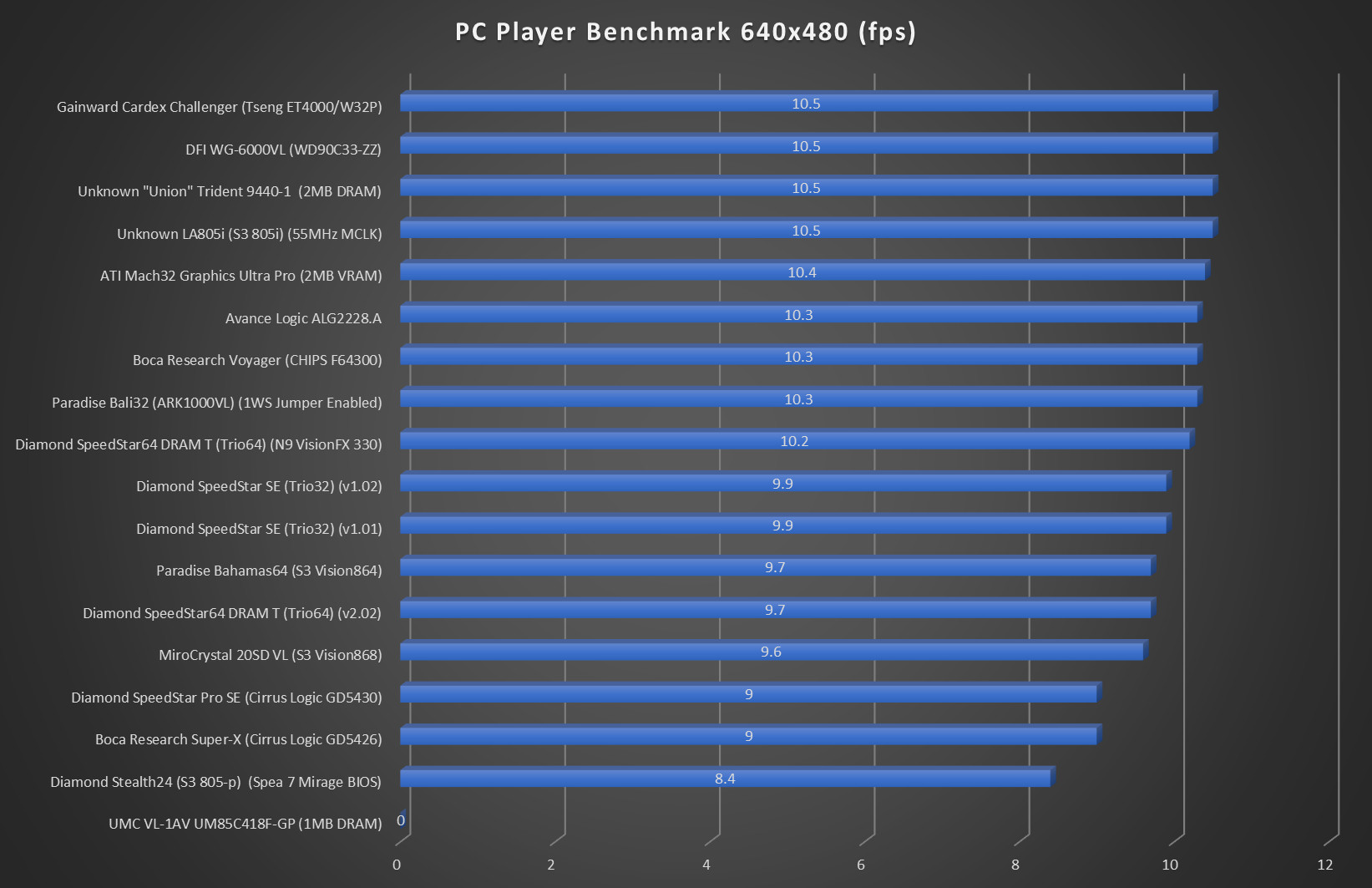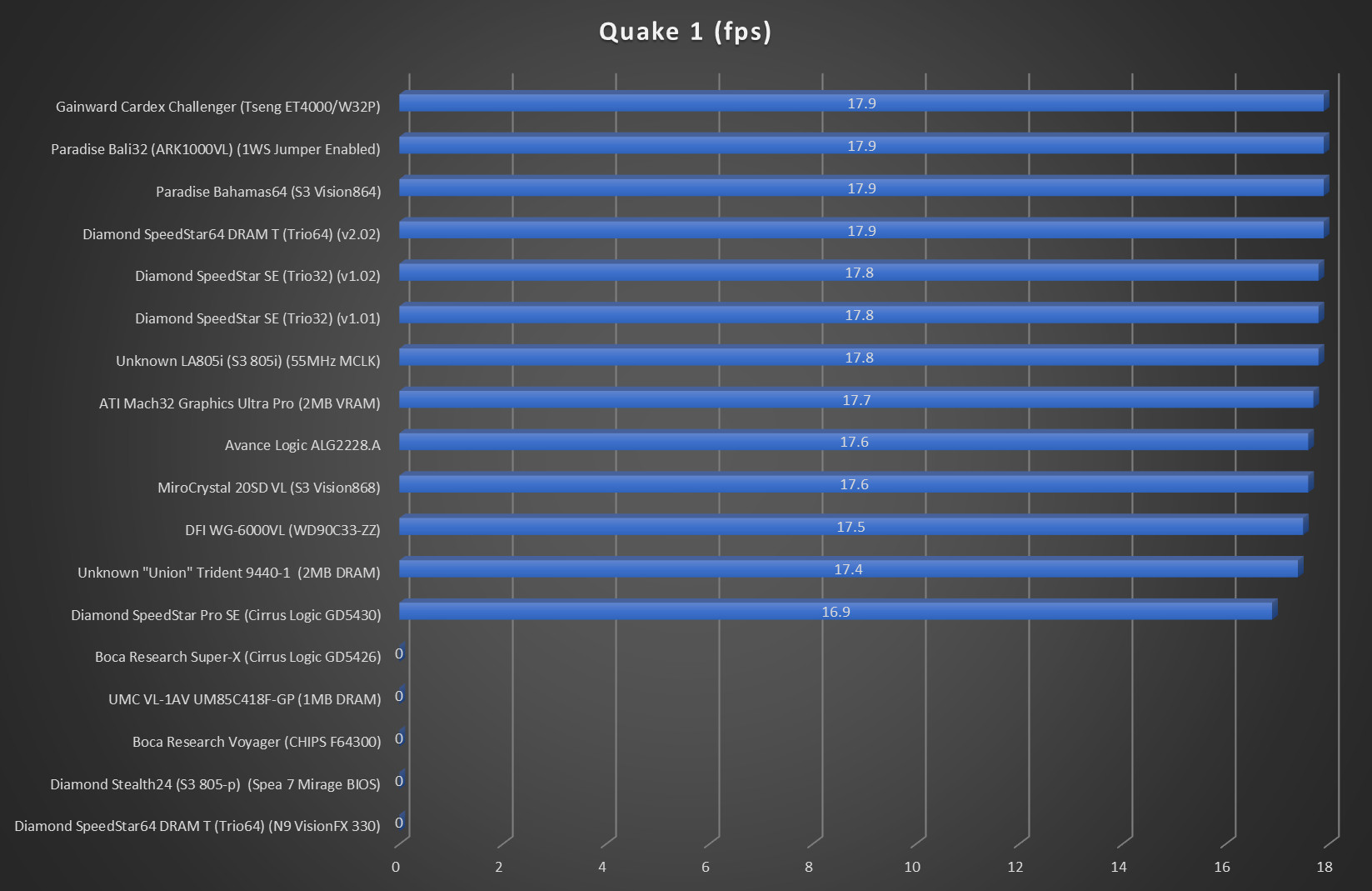@Chadti99
Thanks for the N9 BIOS! It worked very well.
Results are below. It is certainly faster.
---
@pshipkov
Re: S3 805. Very whacky. I just tested it today on the SuperEISA.
DOS numbers are impressive, Windows above/around average.
I've got a Stealth24 equipped with a "regular" 805-p for comparison to test soon.
Interesting tests you found! Thank you for sharing.
Seems the 77C32BLT is decent. It will be interesting to see how it compares.
I read something today saying the Alliance ProMotion 3210 is also pretty fast; should be in the same class of late/weird VLB cards.
That page is pretty funny, but definitely has some nice reference. Still can't help but wonder where some of the data came from.
I have a few random cards, but mostly the usual suspects: Trio32, Trio64, S3 864/868, Mach32, S3 805/i, WD90C33-ZZ, UMC418F, Trident 9440-1, Chips F64300, ARK1000VL, and a boxed/unopened Mach64 VRAM VLB. I have the upgrade module for the last one as well and was initially planning to unbox it on YouTube. I would like to archive and preserve the manual and everything, and want to see that beast in action. I have a soft spot for the weird Mach cards.
As far as EIDE stuff, I have an EIDE2300Plus, a couple of other IDE adapters that I haven't really looked into, and two VLB ethernet cards. One is a BocaLanCard VLB, NIB, but I'll open and use that soon. I am from Boca so it's almost become a hobby to collect their hardware 😀 The other is stubborn and has an SMC91C92 chip. I need to try it in Win95.
I recall some change with MCLK, but some cards have "factory-optimized" BIOS memory timings, or so it seems.
Needs further investigation, but cards with faster DRAM seem to have tighter timings--except ARK1000VL.
All ARK1000VLs have 70ns RAM. Puzzling.
Planning on testing MCLK on Miro 20SD this week; initial numbers at 4 x 40MHz were not as hoped.
Could be due to 70ns EDO vs 60ns on 864, but unlikely. Numbers within a reasonable delta, but below 864.
Diamond 868 and N9 868 BIOSes from web did not work.
Re: Predator Chips
I plan on definitely optimizing things and adding some edits!
It's an impressive board, but I feel a bit let down compared to "the beast."
SuperEISA takes its lunch money and does so without missing a beat.
Increasing the L2 seems most reasonable. I plan to test at first with 256k 10ns cache to see what that brings.
The LS486E seems totally fast with 256k L2, maybe this is another board in that vein?
Thanks for the suggestions re: VLB cards. I think the 964 may be my next pickup, unless a 968 appears.
Seems that the 964/968 are a bit faster than the Trio64 in Windows at higher res. Interesting.
Curious too, whether ATI Mach64 w/ 4MB VRAM can handle a 964/968.
GD5434 is for another day. While I like Cirrus, it sounds like nothing too out of the ordinary.
I've been doing some BIOS swapping. The N9 BIOS worked on my SpeedStar64 DRAM T very well, but failed in Quake. This will be investigated further.
The Trio32 and Chips F64300 also could not handle Quake at full speed. Seems like they are not as well-buffered.
----
Initial Thoughts: For an early 486 board, with an unsophisticated, non-highly-integrated chipset, dating to 1992, this board is nuts. While the AMI BIOS uses the commonplace HI-Color 6/6/92 core, the board’s performance and implementation is brilliant. All aspects were carefully designed. The PCB is of top-notch quality, and many chips are socketed for ease. This board can take 1024k L2 cache and likes the "10ns" parts, running them at max timings w/out wait states at 40MHz. Can cache all 256MB (seemingly) of 30-pin SIMM RAM and allows for DRAM interleave. Provides WB L2 cache, but no L1 WB, sadly. No VRM, so VRM interposer is used for clockspeed and voltage adjustment. Board runs happily at 50MHz FSB+ and some users have reported 66MHz FSB success. Speed is easily adjusted via oscillator, and clockgens can be used instead. Only provides one VLB slot, but EISA makes up for the rest. Wide, fast bus with lots to offer, and easy configuration.
All timings were set to their minimum, all waitstates were disabled, and FSB was reported at 40.0MHz in ChkCPU.
The attachment IMG_2421.jpg is no longer available
The attachment NICE_SUP.jpg is no longer available
Impressions: Overall, an excellent board. A top performer, for sure. Impressive metrics in synthetics and real-world benchmarks. The SiS406/411 chipset is potent, and offers much to the end user in terms of stability and reliability. This board can take anything thrown at it; 1024k L2? Check. VLB? Check. EISA? Check. Unfortunately, it is limited to 1 VLB slot. But the double-banked 30-pin RAM configuration enables 256MB of fully cacheable RAM, and no modifications are needed for any of this. This board can take clockgens, oscillators, and has few jumpers relative to most anything its age.
Easy, reliable, fast. Cream of the crop.
----
EDIT: pshipkov's notes:
"Couple of conclusions from the captured metrics:
Slightly behind the average at VGA graphics - Wolf3D and Doom. Predator 747 Chips does better here.
Top notch at CPU/FPU intensive tasks - PC Player, Quake 1 and 3D Studio.
Top notch at accelerated Windows GUI - WinTune 2."
Agreed on all fronts. VLB performance is not 100% w/r/t DOS VGA.
Curious as to whether design, implementation, BIOS, or something else.
Will investigate and report.
----
3DStudioR3: 110 seconds
EDIT :Added more cards, including S3 805-p, Trident 9440-1, ALG2228.A, and UM85C418F-GP.
EDIT #2 :Added more cards, including GD5426 and WD90C33-ZZ. Got Miro20SD stable in Win3.1 for GUI testing. Strange results.
EDIT #3 :Added Tseng ET4000/W32P. Re-ran tests with I/O Recovery increased from lowest at 3 BCLK. Helped some boards clear Quake. Scores annotated below.
EDIT #4 :Added Diamond SpeedStar Pro SE GD5430. Not impressed. Acceptable/Trio32 level in Windows, below-average in DOS.
EDIT #5 :Added charts. Finalized WinTune2 score for ARK1000VL.
EDIT #6 :Added S3 Vision964 numbers (Miro 20SV). Need to update charts...
EDIT #7 :Added S3 new S3 Vision868 numbers (Diamond Stealth Video 2000 Series). Mach32 DRAM tested. (Graphics Ultra Plus). Mach64 Graphics Pro Turbo w/ 4MB VRAM tested. New chart with all data appended.
Summary Charts (Continuously Updated):
Individual Charts are at Bottom(will be updated in a few days)
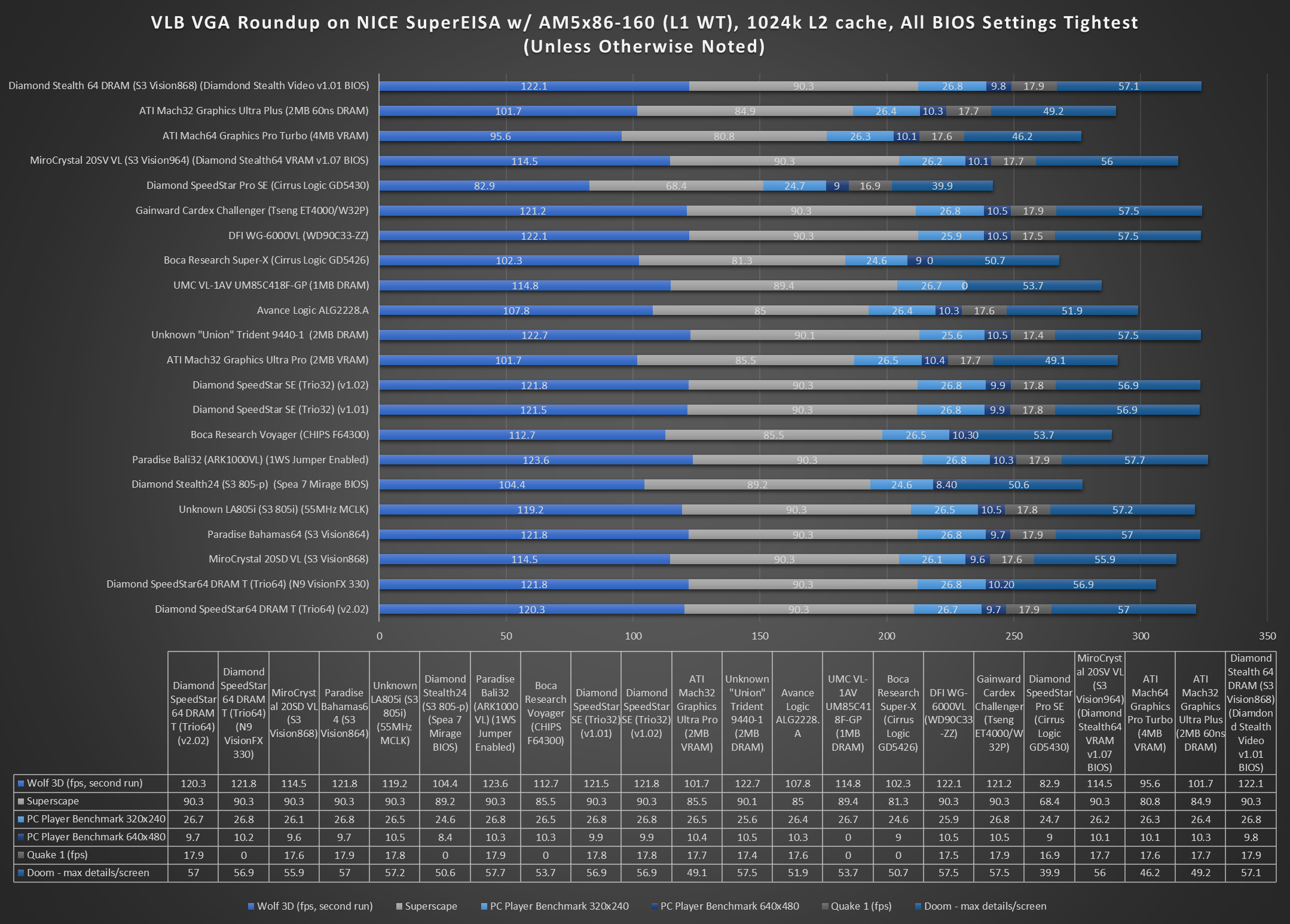

ARK1000VL (1ws enabled)
Wolf3D: 123.6 fps
PC Player: 26.8 (10.3 fps @ 640x480)
Doom: 57.7 fps
Quake 1: 17.9 fps
WinTune 2: 7634 KPixels/second
Gainward Cardex Challenger (Tseng ET4000/W32P)
Wolf3D: 121.2 fps
PC Player: 26.8 fps (10.5 fps @ 640x480)
Doom: 57.5 fps
Quake 1: 17.9 fps
WinTune 2: 10197 KPixels/second
MiroCrystal 20SV (S3 Vision964 w/ Diamond Stealth64 VRAM H BIOS)
Wolf3D: 114.5 fps
PC Player: 26.2 fps (10.1 fps @ 640x480)
Doom: 56.0 fps
Quake 1: 17.7 fps
WinTune 2: 13525 KPixels/second
S3 Trio64 (Stealth64 v2.02)
Wolf3D: 120.3 fps
PC Player: 26.7 fps (9.7 fps @ 640x480)
Doom: 57.0 fps
Quake 1: 17.9 fps
WinTune 2: 12495 KPixels/second
Diamond Stealth 64 DRAM (S3 Vision868) (Diamdond Stealth Video v1.01 BIOS)
Wolf3D: 122.1 fps
PC Player: 26.8 fps (9.8 fps @ 640x480)
Doom: 57.1 fps
Quake 1: 17.9 fps
WinTune 2: 13347 KPixels/second
S3 Trio64 (Stealth64 N9 FX530 BIOS)
Wolf3D: 121.8 fps [+1.5]
PC Player: 26.8 fps (10.2 fps @ 640x480) [+0.1, 0.5]
Doom: 56.9 fps [-0.1]
Quake 1: DNF [Unstable at even 11BCLK I/O Recovery]
WinTune 2: 11699 KPixels/second [-]
MiroCrystal 20SD (S3 Vision868) -- NEED TO REVISIT
Wolf3D: 114.5 fps
PC Player: 26.1 fps (9.6 fps @ 640x480)
Doom: 57.0 fps
Quake 1: 17.6 fps
WinTune 2: 10868 KPixels/second
**Are there 868-specific Win3.1 drivers? The 868 ones I found seem to be the same as the 864 drivers.**
**EDIT: Found original Miro drivers. Quirky, meant for CRTs, but work well. Offer a "max performance mode" that seems unstable.**
Paradise Bahamas 64 (S3 Vision864)
Wolf3D: 121.8fps
PC Player: 26.8 fps (9.7 fps @ 640x480)
Doom: 57.0 fps
Quake 1: 17.9 fps
WinTune 2: 11955 KPixels/second
Unknown LA805i (S3 805i-p, MCLK at 55MHz)
Wolf3D: 119.2 fps
PC Player: 26.5 fps (10.5 fps @ 640x480)
Doom: 57.2 fps
Quake 1: 17.8 fps
WinTune 2: 7893 KPixels/second
Diamond Stealth24 (S3 805-p) (Spea 7 Mirage BIOS)
Wolf3D: 104.4 fps
PC Player: 24.6 fps (8.4 fps @ 640x480) [VESA TSR required for SVGA]
Doom: 50.6 fps
Quake 1: 16.9 fps* (I/O Recovery 11 BCLK)
WinTune 2: DRIVER ISSUES
**Card will NOT operate at 40MHz with default Diamond Stealth24 BIOS v2.00**
Boca Research Voyager (Chips F64300)
Wolf3D: 112.7 fps
PC Player: 26.5 fps (10.3 fps @ 640x480)
Doom: 53.7 fps
Quake 1: DNF
WinTune 2: 8537 KPixels/second
Diamond SpeedStar SE (Trio32 v1.01), Diamond SpeedStar SE (Trio32 v1.02)
Wolf3D: 121.5 fps / 121.8 fps
PC Player: 26.8 fps (9.9 fps @ 640x480) / SAME
Doom: 56.9 fps / SAME
[Change in Doom min details of 0.4 fps from 171.4 to 171.5]
Quake 1: 17.8 fps / 17.8 fps* (I/O Recovery 11 BCLK)
WinTune 2: 6096KPixels/second
ATI Mach32 Graphics Ultra Pro (2MB VRAM)
Wolf3D: 101.7 fps
PC Player: 26.5 fps (10.4 fps @ 640x480) [VESA TSR required for SVGA]
Doom: 49.1 fps
Quake 1: 17.7 fps
WinTune 2: 9458 KPixels/second
ATI Mach32 Graphics Ultra+ (2MB 60ns DRAM)
Wolf3D: 101.7fps
PC Player: 26.4 fps (10.3 fps @ 640x480) [VESA TSR required for SVGA]
Doom: 49.2 fps [+0.1 fps]
Quake 1: 17.7 fps
WinTune 2: 7090 KPixels/second
ATI Mach64 Graphics Pro Turbo (4MB VRAM)
Wolf3D: 95.6 fps
PC Player: 26.3 fps (10.1 fps @ 640x480)
Doom: 46.2 fps
Quake 1: 17.6 fps
WinTune 2: 12795 KPixels/second
NOTE: This card seems to have compatibility issues on this board, yielding lower performance.
These issues are related specifically to the memory aperture feature, as well as EISA CFG issues w/r/t this particular card.
Will revisit later.
Unknown "Union" Trident 9440-1 (2MB DRAM)
Wolf3D: 122.7 fps
PC Player: 25.6 fps (10.5 fps @ 640x480)
Doom: 57.5 fps
Quake 1: 17.4 fps
WinTune 2: DNF -- Need 9440-1 specific drivers? AGI ones do not work.
Avance Logic ALG2228.A (1MB 45ns DRAM)
Wolf3D: 107.8 fps
PC Player: 26.4 fps (10.3 fps @ 640x480)
Doom: 51.9 fps
Quake 1: 17.6 fps* (I/O Recovery 11 BCLK)
WinTune 2: 5588 KPixels/second
Diamond SpeedStar Pro SE (Cirrus Logic GD5430)
Wolf3D: 82.9 fps
PC Player: 24.7 fps (9.0 fps @ 640x480)
Doom: 39.9 fps
Quake 1: 16.9 fps
WinTune 2: 6196 KPixels/second
UMC VL-1AV UM85C418F-GP (1MB 80ns DRAM)
Wolf3D: 114.8 fps
PC Player: 26.7 fps (N/A @ 640x480) [VESA TSR required for SVGA (Does anyone have?)]
Doom: 53.7 fps
Quake 1: DNF
WinTune 2: 1526 KPixels/second (Does this card even have GUI acceleration features?)
**HWINFO reports 16-bit external bus for this card. Would be interesting to see if true.**
Boca Research Super-X (Cirrus Logic GD5426)
Wolf3D: 102.3 fps
PC Player: 24.6 fps (9.0 fps @ 640x480)
Doom: 50.7 fps
Quake 1: DNF
WinTune 2: 3427 KPixels/second
DFI WG-6000VL (WD90C33-ZZ)
Wolf3D: 122.1 fps
PC Player: 25.9 fps (10.5 fps @ 640x480)
Doom: 57.5 fps
Quake 1: 17.5
WinTune 2: 5434 KPixels/second

